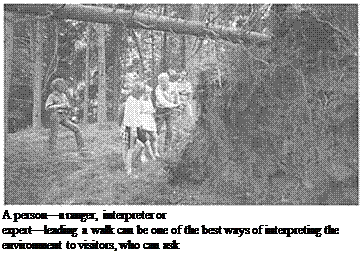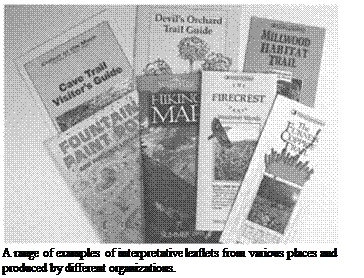The media available for conveying interpretation are:
– people telling the story;
– leaflets;
– portable tape recorders;
– on-site panels (including listening posts);
– exhibition areas;
–
 |
visitor centres.
questions, discuss issues and
perhaps be more convinced of the need to protect areas.
People telling the story
For many sites, especially those with complex and detailed stories and where the audience is likely to be a curious one, people who can explain and answer questions are very effective, although costly. There is the added advantage that the landscape is not littered with interpretative panels or signs detracting from the enjoyment of those people who may find such devices intrusive.
 |
Listening to an enthusiastic and knowledgeable guide can be very rewarding, and there is the added feeling of reassurance for those who are afraid of getting lost or misjudging how long it takes to follow a
trail. The rangers who lead the walks can also monitor visitor activity, especially on the more popular parts of the area, and supervise behaviour when necessary.
Ideally the ranger, interpreter and designer should collaborate in planning and designing the trails that lead to particular places of interpretative value for storytelling. This might include providing areas with benches where a larger group can be seated while the ranger tells the story. The surfacing, gradients, length of trail and the presentation of its features should be designed for the selected audience (see Chapter 9).
At some visitor centres or at campgrounds in national parks and national forests there might be a demand for outdoor lecture theatres. These involve tiers of seats set in an open natural hollow or amphitheatre with good natural acoustics, electrical provision for audiovisual projection and a screen, a campfire ring and perhaps a low stage or dais. The campers can sit around the fire to hear stories, sing songs or look at films or slide shows. Thus they can be entertained and informed at the same time.
The design of these amphitheatres should take into account the capacity of the campground and therefore the potential audience size, the type of weather (in rainy places the stage and screen might need shelter), and the type of design character that is appropriate. In some places (the more rural or urban ROS characters) more formal benches and harder surfacing might be appropriate, whereas in wilder areas logs or stone seating might suffice, or even a mown grassy bank for informal sitting on rugs or groundsheets.
A wooden stand with weather protection (glass-fronted box) for a projector together with an extending screen kept in another structure forming part of the stage or dais backdrop will be needed for regular slide shows. White screen surfacing must be maintained, and should not be kept out in the open air to become dirty, mouldy or sooty.



